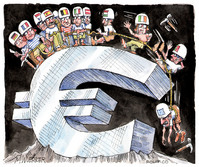Once again, the Greek crisis is the focus of attention and epitomizes Europe’s failings. Once again, hard decisions have to be made about debt restructuring and the provision of further assistance to Athens. And once again, the Europeans have to accept that the situation is more serious than they thought.
But the depth of Greece’s woes should not obscure the fact that it is a small economy and, in many respects, an extreme, special case. No other country flouted the European Union’s budget rules the way Greece did, or has accumulated as large a public-debt burden, and no other EU country combines to the same extent a dysfunctional state and an uncompetitive private economy.
The real battle is being fought in Italy and Spain. Both countries’ borrowing conditions deteriorated in the second half of 2011. Both are so large – accounting for 17% and 11% of eurozone GDP, respectively – that financing them through multilateral assistance would strain, if not exhaust, the resources of the eurozone and the International Monetary Fund. Both recently installed new, reform-minded governments. And both are struggling to rebuild competitiveness, foster growth, restore fiscal soundness, and clean up banks’ balance sheets. If they succeed, the euro will survive; if they fail, it won’t, at least in its present form.
That is why discussions over the last few months have largely, if implicitly, been about how to support adjustment and reform in Italy and Spain. Proposals to permit the European Central Bank to intervene more decisively in bond markets, or to increase the size of the “firewall” by leveraging the European Financial Stability Facility (EFSF), were intended to set an upper limit on interest rates paid by Italy and Spain on their debt emissions.
Similarly, proposals to create common bonds were intended to quell expectations of insolvency by ensuring that these countries would eventually be able to borrow against their eurozone partners’ guarantee. All of the discussions were couched in general terms, but everybody had the same specific countries in mind.
None of these proposals, it seems, will be implemented anytime soon. The ECB has bought some Italian and Spanish bonds, and it might buy more, but it has made clear that it is not ready to commit to a ceiling for long-term interest rates. The EFSF’s size will be increased by accelerating the creation of the permanent European Stability Mechanism, and by letting it overlap with the EFSF. But the EFSF’s capacity will remain at roughly €500 billion – well below the €1 trillion-plus envisaged by those who advocate bringing massive financial firepower to bear (the so-called “bazooka solution”).
Likewise, Eurobonds are officially off the agenda, at least for now. Rather, Europe is putting in place a new fiscal compact to ensure that all eurozone countries adopt and implement stringent budgetary rules.
These choices partly reflect pragmatic concerns: all of the financial-engineering schemes that have been proposed to protect Italy and Spain from aggravated borrowing conditions raise legal, political, or governance difficulties. But there is a principle at issue as well: it is thought (particularly in Germany) that protection from market pressure would only impede adjustment and reform.
Indeed, the perception in Northern Europe is that only serious strains provide the required incentives to overcome domestic political and social obstacles to slashing public spending and reforming labor markets. For Southern Europe, no pain means no gain: a deep recession and a sharp increase in unemployment may be the price of lasting improvements in productivity and competitiveness.
This reasoning is not without justification. Soon after the ECB began buying Italian bonds last August, then-Prime minister Silvio Berlusconi’s government backtracked on its commitments to tax reform. Even though it later reversed its stance, the episode was widely regarded as clear evidence of the moral-hazard effect of ECB support. Only after the bond market turned on Berlusconi again was he replaced by the reform-minded Mario Monti.
But the strategy is a high-risk gamble. Governments may need incentives to act, but they also need to be able to show their citizens that reform pays. If, after a few quarters of fiscal adjustment and painful reform, output is lower, unemployment higher, and the outlook darker, governments may soon lose public support and reform may stall, as we have seen in Greece. Reform-minded teams may lose power to populists.
Furthermore, a degraded macroeconomic and financial environment increases the likelihood of bank failures, with immediate consequences for public finances and economic confidence.
These risks are compounded by the need for reform in several countries at once. Indeed, there is a “fallacy of composition” in the current approach: the countries in need of serious adjustment and improved competitiveness include the whole of Southern Europe and France, and jointly account for more than one-half of eurozone GDP. True, competition for investment is an incentive to act. But macroeconomic and financial interdependence may render success elusive if reforming countries face an adverse regional environment of stagnating or falling demand.
It is one thing to believe that governments act only under pressure, and that societies accept reforms only if they believe that there is no other alternative; it is quite another to believe that adjustment and reform will proceed if all of Southern Europe is struggling with recession. Keeping Southern Europe on a short leash would be a more credible strategy if accompanied by a growth program for the entire eurozone. And, at this stage, such a program is nowhere in sight.
Jean Pisani-Ferry is Director of Bruegel, an international
economics think tank, Professor of Economics at Université Paris-Dauphine, and
a member of the French Prime Minister’s Council of Economic Analysis.
Jean Pisani-Ferry:
歐元區的苦肉計
發自布魯塞爾——歐元區已經連續第三年成為全球經濟最薄弱的一環。在2010年,焦點集中在希臘,葡萄牙和愛爾蘭等歐元區外圍國家的危機。到了2011年,危機逐漸向核心區域轉移,意大利和西班牙開始坐立不安,甚至有越來越多的人開始質疑歐元區本身的生存能力。而2012年所面臨的問題則是這種緊張態勢是否將得到緩解,還是掀起下一個新的高潮。
再一次,希臘危機成為眾人的焦點以及歐洲自身缺陷的縮影﹔再一次,人們必須在債務重組和向雅典提供進一步援助方面做出艱難的決定﹔也再一次,歐洲人必須認識到情況要比他們想象中更為嚴峻。
但希臘的苦況也不應掩蓋一個事實:它隻是一個小型經濟體,而且在許多方面都是一個極端而特別的例子。沒有任何一個國家膽敢如此漠視歐盟的預算規定,或是積累了如此巨大的公共債務負擔,也沒有一個歐盟國家能將一個無法運作的國家機器和一個缺乏競爭力的私營經濟結合到如此惡劣的程度。
但意大利和西班牙所面對的才是硬仗。兩國的借債狀況都在2011年下半年出現惡化﹔兩國都是大型經濟體——分別佔歐元區GDP總量的17%和11%,以致任何多邊資金援助手段都將大量佔用(甚至可能耗盡)歐元區和世界貨幣基金組織的資源﹔兩國最近都組建了新的改革派政府﹔兩國都盡力重建競爭力,促進增長,恢復財政穩定,並著手清理銀行的資產負債表。如果這些措施能成功的話,歐元就能存活下來﹔反之則將走向衰亡,至少無法維持現有的形式。
這也是為何過去幾個月的討論大多——如果沒有異議的話——集中在如何支持意西兩國的調整和改革之上。類似允許歐洲央行更強力干涉債券市場或者通過杠杆化歐洲金融穩定基金的方式來增加“放火牆”厚度的提議,都在試圖為兩國釋放債務時所需支付的利率設定一個上限。
同樣,那些設定共同債券的提議都試圖說服人們:這些國家最終一定能在其他歐元區伙伴國的保証下獲得借款,破產預期是不可取的。雖然所有這些討論都用一些籠統的詞匯來表達,但大家其實心中都明白說的就是那幾個國家。
但似乎上述幾個提議中沒有幾個能在近期推行。歐洲央行已經買入了一些兩國國債,甚至可能再多買一點,但該行同時也明確表示不會為長期利率設定一個上限。歐洲金融穩定基金的規模已經通過永久性的歐洲穩定機制(European
Stability Mechanism)的加速創設以及允許后者與前者進行重疊而得以擴大。但基金依然會維持在大約5000億歐元的水平,依舊遠低於那些鼓吹實施1萬億歐元以上大規模金融火力——所謂“巴祖卡火箭炮方案(bazooka
solution)”——的成員所設想的規模。
同樣,歐洲債券也被正式排除在議程之外——至少目前如此。取而代之的則是歐洲推行一個新的財政協議以確保所有歐元區國家都能採納和實施嚴格的預算管制。
這些選擇都在某種程度上反映了實用主義的觀點:所有旨在防止意西兩國借債狀況惡化的金融推進方案都會引發諸多法律,政治和治理難題。但其中也存在著一個流行的理念(尤其是在德國國內):認為保護這些國家免遭市場壓力隻能阻礙調整和改革。
事實上,歐洲北部各國的看法就是隻有高壓才能提供克服國內政治和社會障礙所需的激勵因素,最終實現支出削減以及勞動力市場改革。而對南歐國家來說,沒有犧牲何來收獲:一場大衰退和失業率的大增或許是生產力和競爭力持續改善所必須付出的代價。
這個推論也不是沒有道理的。就在歐洲央行於去年八月開始購買意大利債券的時候,時任意大利總理的貝盧斯科尼卻突然放棄了推行稅收改革的承諾。即便該政府后來又重新回到了原來的立場,這一幕也被廣泛認為是歐洲央行所提供的支持所帶來的道德破壞效應的明確証明。也隻有在貝盧斯科尼被改革派的馬裡奧·蒙蒂所取代之后債券市場才拋棄了前者。
但這個策略其實是一場高風險的賭博。各國政府或許需要在激勵因素的刺激之下才能行動,但他們也需要告訴市民們改革是可以帶來好處的。如果在一系列財政調整和痛苦改革之后產能,失業率和前景進一步惡化,那麼這些政府將迅速失去公眾支持而改革也將陷入停滯,正如我們在希臘看見的那樣。改革派團隊也將大權旁落,讓位給那些民粹主義者。
此外,一個惡化的宏觀經濟和金融環境增加了銀行破產的可能性,也將迅速影響公共財政狀況和市場信心。
在多國急需立刻改革的需要之下風險也進一步加大了。事實上,目前的手段中存在著一個“混合的錯誤推論”:那些急需大幅調整並提升競爭力的國家包含了整個南歐地區以及法國,經濟總量相當於歐元區GDP的一半。對投資的競爭毫無疑問是一個行動起來的激勵因素。但如果那些改革中的國家面對經濟停滯或者需求下降這類負面區域環境的話,宏觀經濟以及金融方面的獨立性就將反過來阻礙改革的成功。
可以確信的隻有一點:政府隻有受到了壓力才會行動,各國社會也隻有在無路可走的情況下才選擇改革﹔還有一點則是隻有所有南歐國家都在衰退中掙扎的情況下改革才能繼續下去。將南歐國家管束起來是一個策略,但隻有在與一個針對全歐元區的增長計劃相結合的情況下這一策略才能變得更加可靠。但在現階段,這麼一個計劃還無影無蹤。
Jean
Pisani-Ferry 是國際智庫機構“勃魯蓋爾(Bruegel)”總裁,巴黎第九大學經濟學教授,同時兼任法國總理經濟分析委員會委員。
